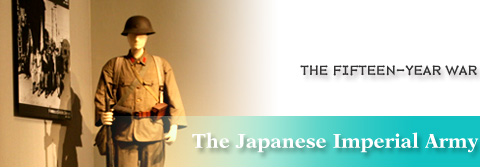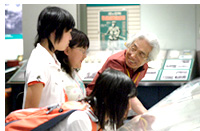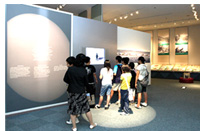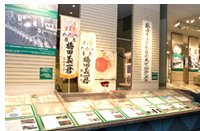| |


|
|
 |
 |
The Japanese armed forces were built around a system of conscription that
made military service a duty of all male Japanese citizens. The constitution
established the Emperor as commander-in-chief of the armed forces;soldiers were
told  that all orders from their superiors were to be considered orders from the
Emperor himself. The human rights of the soldiers were severely suppressed, and
emphasis was put on mental rather than physical strength: weapons were old fashioned
and supplies were poor. Inevitably,these conditions resulted in increasing numbers
of deaths in the ranks. that all orders from their superiors were to be considered orders from the
Emperor himself. The human rights of the soldiers were severely suppressed, and
emphasis was put on mental rather than physical strength: weapons were old fashioned
and supplies were poor. Inevitably,these conditions resulted in increasing numbers
of deaths in the ranks.
|
 |
In September 1931, Japan invaded northeastern China, initiating what is known in this country as "The Fifteen-Year War".
Japan later used the Marco Polo Bridge (Lukou-chiao) Incident of July 1937 as
a pretext to launch an all-out war against China. When it found it was no longer
moving ahead in that region, the nation started the Pacific War in December of
1941, declaring war against the U.S., the United Kingdom and the Netherlands.
This led to Japan's eventual defeat on August 15th, 1945 and its official surrender
on September 2nd of that year.  During those 15 years, Japanese military forces
carried out indiscriminate bombing and used poison gases and biological weapons
against China and other countries. In war zones, they killed and tortured soldiers
and civilians alike, their operations aimed at totally destroying areas that
put up resistance. During those 15 years, Japanese military forces
carried out indiscriminate bombing and used poison gases and biological weapons
against China and other countries. In war zones, they killed and tortured soldiers
and civilians alike, their operations aimed at totally destroying areas that
put up resistance.
|
 |
Most of the men recruited into the military from the Kyoto area went into the 16th Division of the Imperial Army, which was stationed in the Fushimi area in the southern part of the city of Kyoto. There was also a naval contingent stationed in the Prefecture in the northern port city of Maizuru. In addition, many special divisions and reserve units were established in the Prefecture between the end of the Russo-Japanese War in 1905 and the Asia-Pacific Wars of the 1920s and 30s,
The first overseas dispatch of the 16th Division took place during 1934 -
1936, when it was sent to the northeastern region of China (Manchuria) to defend
Japanese positions in the area. After that, thousands of soldiers and sailors
were sent from Kyoto Prefecture to fight in China,  the Philippines and other
countries. Approximately 55,000 of them lost their lives during the Fifteen-Year
War, while about another 100,000 men from Kyoto were stationed in the Philippines,
Burma, China, Okinawa and other areas when Japan finally made its unconditional
surrender in 1945. the Philippines and other
countries. Approximately 55,000 of them lost their lives during the Fifteen-Year
War, while about another 100,000 men from Kyoto were stationed in the Philippines,
Burma, China, Okinawa and other areas when Japan finally made its unconditional
surrender in 1945.
|
| |

|
It is said that by the time soldiers had filled a backpack like this with rations
and extra ammunition and put it on their back, then donned a string of cartridges
and picked up their gun, duffel bag, overcoat, pup tent, and small shovel, their
total load was at least 30 kilograms. Visitors can pick up the backpack on the
round red platform in the middle of the floor to see how heavy it is. (Donated
by Masayuki Hayashi)
|
|
|
| |
|
|
|
 |
|
|
|